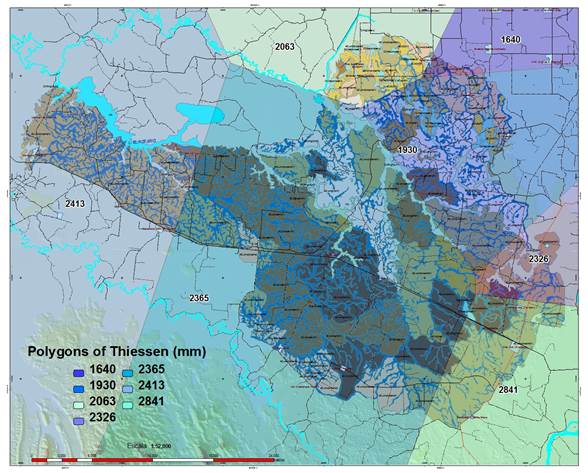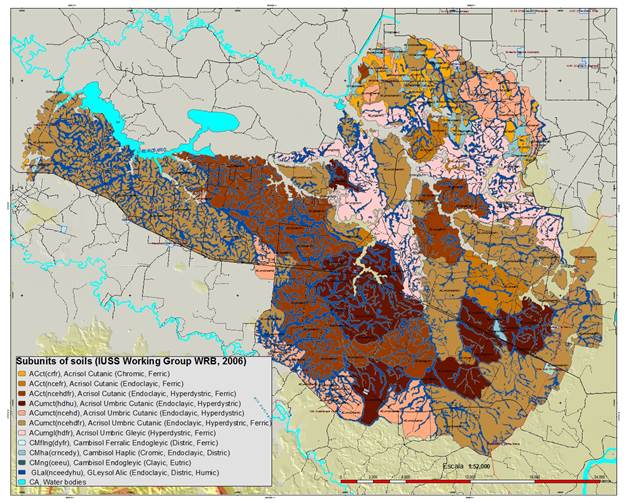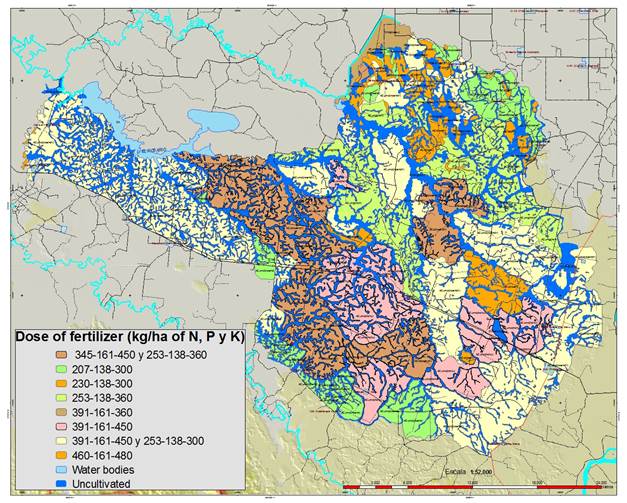Introduction
The commercial production of pineapple in Mexico is carried out with the cultivars Cayena lisa, MD2 and the creole ‘Cabezona’. It is known that production system is nomadic due to the poor phytosanitary management of the vegetative material for new plantings and this contributes to disperse the plant diseases, which causes for the following crop cycle, a new site is used. Approximately 1600 ha of pineapple are cultivated in the Sabana de Huimanguillo, Tabasco-Mexico, from which were obtained 42,621t of fresh fruit. Potential yields of pineapple are as follows: 70 t.ha-1 in Hawaii, Philippines, Thailand and Costa Rica, those that do contrast with the reported 42.48 t.ha-1 for Mexico. Therefore, in Tabasco-Mexico is difficult to estimate yields due the fruit is sold per piece for fresh consumption. In this sense, the factors that most affect fruit yield are as follows: pests and diseases, weeds, nutritional imbalance, low plant population density, soil erosion and acidification, poor flowering control and fruit ripening, water deficit, genetic de-uniformity and poor quality of vegetative material (Teixeira et al., 2011).
Likewise, due to the acid soils low fertility where pineapple plantations are cultivated in Mexico, which are characterized by high phosphorus fixation, boron deficiencies, calcium, magnesium, potassium and zinc, low rate of ammonium formation and nitrates, in addition to a high percentage of aluminum saturation (Salgado et al., 2013; Zavala et al., 2014). These restrictive fertility conditions are manifested in foliar deficiencies, which affect the pineapple yield and quality. With the above mentioned, it is difficult to develop management practices that improve a long-term soil fertility. Given these concerns, in order to address the nutritional problem of pineapple cultivation, a sustainable fertilization program was developed to increase pineapple yields in soils of the Savannah of Huimanguillo on Tabasco, Mexico.
Materials and methods
The study area is located to the center-southeast of the municipality of Huimanguillo, Tabasco-Mexico inside the area of pineapple plantations. Specifically, extreme geographical coordinates are as follows: 17° 35´ 25´´ and 17° 56´ 41´´ N, and 93° 26´ 08´´ and 93° 56´ 31´´ W. This area occupies an extension of 106,499 ha, performs a humid warm Af(m) rainy season throughout year, with an average temperature of 26.1°C and annual rainfall of 2290.3 mm. For the study, a proposed methodology implied in an Integrated System for Recommending Fertilizer Doses (ISRFD) was used, which consisted of seven phases (Salgado et al., 2013) as follows:
Climatic characterization
To facilitate a more precise estimation, consisted of two processes. In the first one, an average monthly records from 1971 to 2000 of the maximum and minimum temperatures (ºC), rainfall (mm) and evaporation (mm) from the Mosquitero (00027033) meteorological station (CONAGUA, 2009), were analyzed. With this information, a climatogram was generated. For the second, data from nine meteorological stations close to Huimanguillo pineapple zone, Tabasco-Mexico, were used to calculate the average annual rainfall from 1971 to 2000, each rainfall cell was georreferenced on the generated soil map to define Thiessen polygons of the average annual rainfall, using ArcGIS 9® software (ESRI, 2008).
Soil survey to define the major groups and/or soil subunits
Twenty-seven soil profiles from a previous study in the same study area were properly selected (Salgado et al., 2016) and 14 pedological wells were excavated in each identified soil map unit. In fact, soil samples were collected from each evaluated soil horizons to carry out the physical and chemical determinations for their soil classification, according to the official Mexican standard (SEMARNAT, 2002). Laboratory analysis results were used to classify the soils according to the World Reference Base of the Soil Resource (IUSS Working Group WRB, 2006). The cartographic units were labeled with the subunit name, according to the WRB classification. The soil map was drawn at scale 1: 50000 using ArcGIS 9® software (ESRI, 2008).
Soil sampling to characterize soil fertility and calculate N, P and K supplying from each soil subunits
50 pineapple plantations were selected from the subunit map. In each pineapple cultivation, six soil subsamples were collected from 0 to 30 cm soil depth, three in the row and three among plants, following a zig-zag path within the plantation to obtain composite samples (Salgado et al., 2013). Conversely, chemical analyzes were carried out in accordance with the official Mexican standard (SEMARNAT, 2002).
Potential yield estimation to determine the nutrient demand for pineapple crop
Three complete pineapple plants were harvested at each site where soil samples were taken. The biomass was obtained from the plant weight, fruit weight and crown weight (kg), crown and plant biomass were separately grounded and fruits were cut into slices. Each sample was homogenized and 300 g were taken to dry into the oven at 70°C until constant weight was reached. Fertilizer doses were determined using the modified conceptual model, DF = (DEM)/EF (Silva & Rodríguez, 1993). It is important to note that supply was eliminated due to a low fertility of Acrisol soils. The fertilizers efficiency values were considered as follows: N 50%, P 30% and K 60%, respectively. Fertilizer management recommendations were generated taking into consideration soil unit, pH and fertilizer sources (Salgado & Núñez, 2012).
Results
Climatic characterization
For pineapple cultivation, the required rainfall ranges from 1000 to 1500 mm annually. In the Mosquitero station, the average rainfall is 2356 mm, which satisfies the water requirements for pineapple crop (Figure 1).
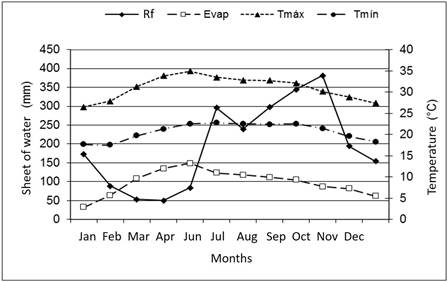
Figure 1 Average behavior for some weather elements in the Mosquitero meteorological station, Tabasco-Mexico. Rainfall (Rf), evaporation (Evap), maximum temperature (Tmax), minimum temperature (Tmin).
Seven Thiessen polygons were generated for the study area, annual rainfall ranges from 1640 to 2841 mm (Figure 2). Minor rainfall occurs in the lower-elevation Northeast, coinciding with the Af climate. In the soils ACumct(ncehdfr), ACct(ncehdfr), ACumgl(hdfr), ACumct(ncect) and CMngl(ceue), is frequent to observe excessive moisture, which reduces the pineapple growth and crop yields.
Soil study
Eleven soil units corresponding to the Acrisol (AC), Cambisol (CM) and Gleysol (GL) groups were identified and soil map was generated at 1: 50000 scale, covering an area of 106,499 ha (Figure 3).
The pineapple crop is established in the study area on eight soil subunits as follows: Acrisol Cuatanic (Endoclayic, Ferric), Acrisol Cuatanic (Chromic, Ferric), Acrisol Cuatanic (Endoclayic, Hyperdystric, Ferric), Acrisol Umbric Cuatanic (Endoclayic, Hyperdystric), Acrisol Umbric Cuatanic (Endoclayic, Hyperdystric, Ferric), Acrisol Umbric Cuatanic (Hyperdystric, Humic), Acrisol Umbric Gleyic (Hyperdystric, Ferric), and Cambisol Endogleyic (Clayic, Eutric).
Nutritional demand
The soil ability to produce greater fresh weight in pineapple crop was as follows (t/ha): ACct(ncefr) > ACumct(ncehdfr) > ACct(ncehdfr) > ACumct(hdhu) >ACumct(ncehd), in pineapple cv. Cayena and MD2, established with 36000 plants.ha-1 (Table 1). Conversely, regarding to cv creole ‘Cabezona’ the type of soils which produced the highest fresh weight were as follows (t/ha): CMng(ceeu) > ACumgl(hdfr) > ACumct(ncehdfr) > ACct(ncehdfr) > ACct(crfr). The observed variability on fresh weight is attributable to the dates of planting, management and the existence of pineapple plantations of second harvest, factors that were not possible to control during the sampling period.
Fertilization dose
The fertilizer doses proposed are presented in Table 2, the N doses fluctuate between 209 to 499 kg.ha-1, P2O5 between 139 to 273 kg.ha-1 and K2O between 298 to 563 kg.ha-1.
With this methodology, eight doses of fertilizers (N-P-K) were generated (Table 2). The fertilizer doses distribution within the study area is presented in Figure 4. In Table 2, the sources of fertilizers are detailed, in which can be observed the use of option 1, which considers the sources of N, P and K of higher concentration, is more economical than the use of the complex.
Table 1 Total biomass, dry matter yield, N-P-K demand per pineapple plant, fruit and crown, cropped on the savanna of Huimanguillo, Tabasco, México.
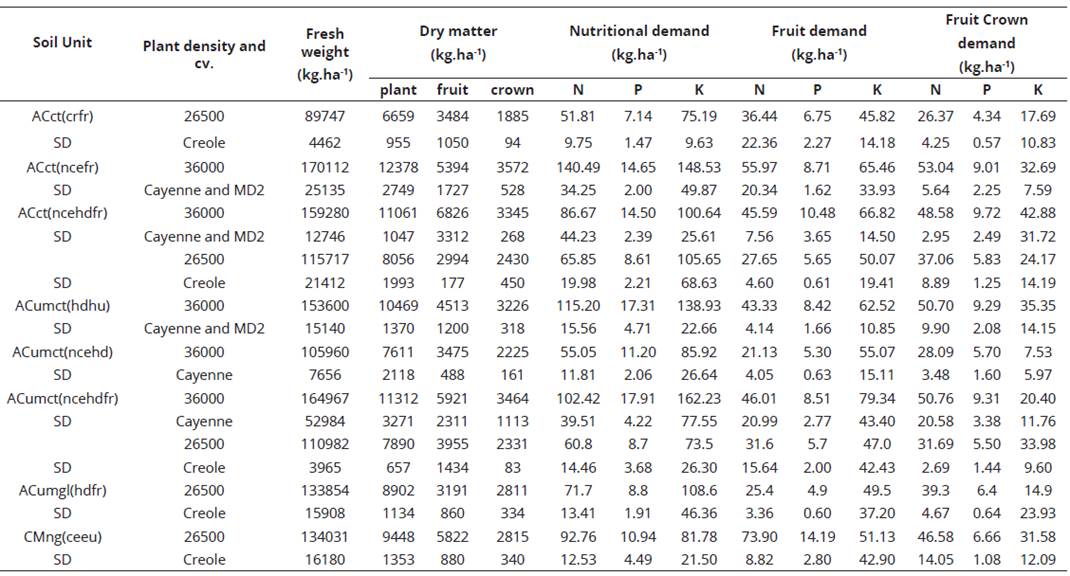
SD: Standard deviation
Table 2 Pineapple fruits yield, fertilizers doses and cost of fertilizer doses for pineapple crop in Huimanguillo, Tabasco, Mexico.
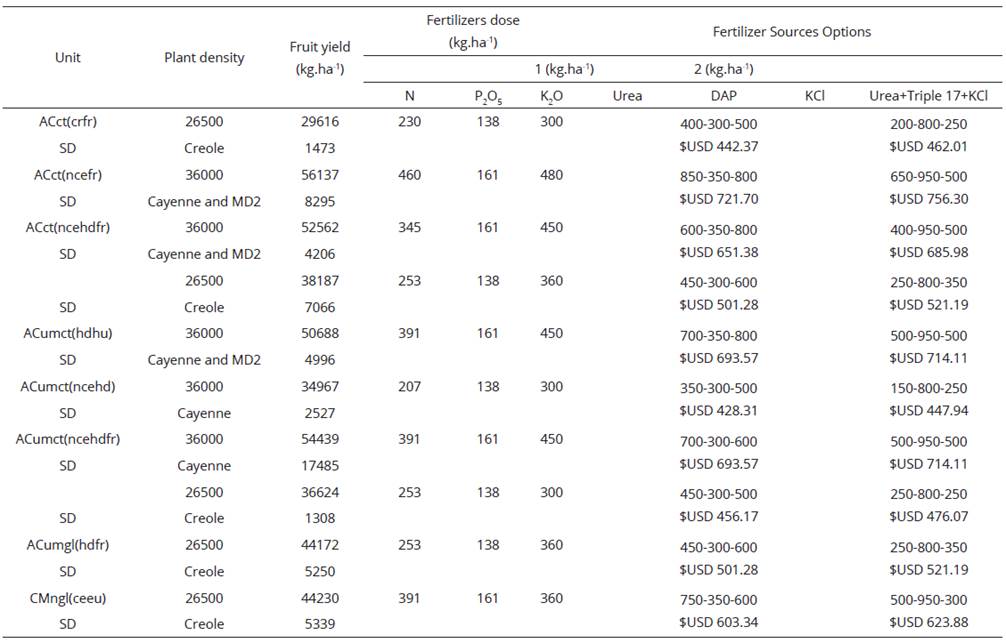
SD: Standard deviation
Discussion
Climatic characterization
During the months of February to May, there is a drought season (276 mm), since the evaporation exceeds rainfall. In fact, this limits the pineapple crop yield and is necessary to apply irrigation to favor the fruit filling. On the other hand, from June to January, rainfall of 2080 mm is registered and is related to humidity excess. The temperatures during the plant growth stage are higher than 20ºC, which favors the crop growth.
Soil fertility
The chemical properties are similar in all subunits; the differences do not implies any change in the soil classification categories and is necessary to establish a soil fertility description in general. The limiting factors of these soils are acidity, clay and deficiencies of P, K, Ca, Mg, Cu, Zn and Mn, respectively (Zavala et al., 2014).
Soil acidity (pH)
The pH of Acrisol subunits was less than 5.0 and is classified as strongly acid (Salgado et al., 2013), and the CMngl (ceeu) unit was moderately acidic. The cultivation of pineapple develops well in soils with pH of 4.5 to 5.0. However, at these pH values the availability of N, P, K, Ca, Mg, Cu and Zn is reduced, with deficiencies occurring in plants. In contrast, the availability of Fe and Al, increases.
Soil organic matter (SOM)
The SOM contents of the soil units vary between 1.8 and 4.5%, ranging from medium to high (<6.0%, SEMARNAT, 2002). From the point of view of sustainability, it is necessary to maintain a minimum level of 3.4% of SOM (Loveland & Webb, 2003). The value above mentioned can be achieved by providing composting from 5 to 10 t.ha-1(Devadas & Kuriakose, 2005). It is advisable to establish a crop rotation based on pineapple-Mucuna-pineapple due to the beneficial effects of the fabaceae species to reduce nematodes and weeds (Matos et al., 2009).
Total nitrogen (TN)
The content of N is considered from rich to very rich (0.15 a 0.30% of N, Salgado et al., 2013). There is a relationship between the OM content and N, a medium to low C/N ratio (<15, SEMARNAT, 2002), which indicates that there will be a net mineralization, and therefore an inorganic N available, but insufficient to meet the >250 kg.ha-1 of required N for this crop (Betancourt et al., 2005; Amaral et al., 2014), is necessary to supply N throughout fertilization.
Assimilable phosphorus (P)
In the soil subunits ACct (crfr) and ACct (ncefr), P content is classified as high. Therefore, soil subunits ACumct (hdhu) and ACumct (ncehd), present medium content (5.5-11 mg) (Borges et al., 2008), which shows these pineapple plantations have received usually phosphate fertilizers. The soil subunits ACct (ncehdfr), ACumct (ncehdfr) and ACumgl (hdfr), present a low content of P (< 5 mg of P, Borges et al., 2008), which is necessary to apply a phosphoric fertilizer to improve the quality of pineapple fruits.
Exchangeable potassium (K)
The K content in the soil subunits is classified as low (<0.20 cmol (+) kg-1 of soil, Salgado et al., 2013). The K contents are less than 30 mg.kg-1, which explains the low sugar content in the fruit if not fertilized with potassium (Halliday & Trenkel, 1992).
Calcium (Ca) and Magnesium (Mg)
The Ca and Mg contents are classified as very low. This reinforces the suggestion of implementing a liming program on these soils (Manica, 1999).
Sodium (Na)
Na is considered a beneficial element for plants, its actual concentration indicates that there are no problems of soil salinity (Salgado et al., 2013).
Cation exchange capacity (CEC)
CEC is classified as low (5 to 15 cmol(+) kg-1 of soil, SEMARNAT, 2002) and indicates that the soils had achieved a low fertility and present kaolinite clays 1:1.
Iron (Fe), Copper (Cu), Zinc (Zn) and Manganese (Mn) micronutrients
The concentration of Fe is classified as high (>4.5 mg.kg-1 of Fe). Cu and Zn are deficient. In fact, Mn is classified as deficient in the following soil subunits: ACct(ncefr), ACct(ncehdfr) and ACumgl(hdfr).
The moisture percentage in the plant fluctuated from 87 to 91%, higher than those reported by Teixeira et al. (2011), and these values served as a basis for calculating the production of dry matter per plant, fruit and fruit crown (Table 2). Therefore, dry matter production showed the same pattern of the fresh weight. The demand for N, P and K, present an order as follows: plant> fruit> crown. All crop components showed the order of requirement K> N> P, as reported by Manica (1999).
Nutritional demand
The N demand for the cultivar Cayenne fluctuated from 124 to 250 kg.ha-1; P from 51 to 82 kg.ha-1; and K from 192 to 338 kg.ha-1, which coincides with that reported by Halliday & Trenkel (1992). Conversely, in the case of the N demand to the creole cultivar ‘Cabezona’ fluctuate from 115 to 213 kg.ha-1; P from 42 to 73 kg.ha-1; and K from 179 to 232 kg.ha-1 (Table 1).
Therefore, when analyzing the total demand of N, P and K, can be observed that pineapple crop demands a great amount of nutrients, which are supplied by soil and are considered as system losses, due to the system of itinerant cropping, these residues when remaining in the field, mineralize by releasing more than 60% of the nutrients and is necessary to think of using a rotation system to take advantage of these nutrients.
Fertilization doses
The eight fertilizers doses (N-P-K) proposed for the pineapple zone of Huimanguillo, Tabasco, Mexico, agree with the recommendations for other pineapple zones of Mexico and the World (450-100-400, Teixeira et al., 2002; 240-120-240, Devadas & Kuriakose, 2005 and Oliveira et al., 2015; 200-50-200, Betancourt et al., 2005).
The pineapple crop fertilization is manual, applied to the soil, the fertilizer is placed from 5 to 10 cm in soil depth, in the area close to the stem and in the older axillar leaves (Teixeira et al., 2011; Halliday & Trenkel, 1992).
Application timing
We recommend start fertilization at the month of planting. A total dose is divided into four parts, which must be applied at three-month intervals (Spironello et al., 2004).
Fertilizers
In the local market the most common fertilizers sources are urea, triple superphosphate, potassium chloride and/or potassium sulfate (Veloso et al., 2001; Spironello et al., 2004; Amaral et al., 2014) and some complexes. However, the most advisable is to calculate the fertilizer doses cost to make an adequate decision, which are the most economical and consider availability at the local market (Salgado et al., 2013).
Conclusions
Resulting from this study was found seven Thiessen polygons, rainfall varies from 1640 to 2841 mm, being the northeast area the driest one. It is known that rainfall of the area covers the water requirements for the pineapple crop and could cause problems of excess moisture in soils with clay texture. The temperatures have allowed a good plant development.
To acquire a more precise evaluation, 11 soil subunits were identified, which corresponding to soil groups: Acrisol (AC), Cambisol (CM) and Gleysol (GL). Pineapple cultivation is carried out in eight soil subunits. The cultivated area can be grouped into three zones: Estación Chontalpa, Francisco Rueda and Nueva Esperanza. The limiting factors of these soils are as follows: acidity, kind of clay, soil moisture excess and deficiencies of P, K, Ca, Mg, Cu, Zn and Mn.
Given these concerns, eight fertilizer doses (N-P-K) were generated, which are represented in a planning and geodesy map based on a geographic information system of fertilizer doses for pineapple cultivation, which are complemented by applications of copper sulphate, zinc, boron, manganese sulphate in some soil subunits in the influence area grown in pineapple.













